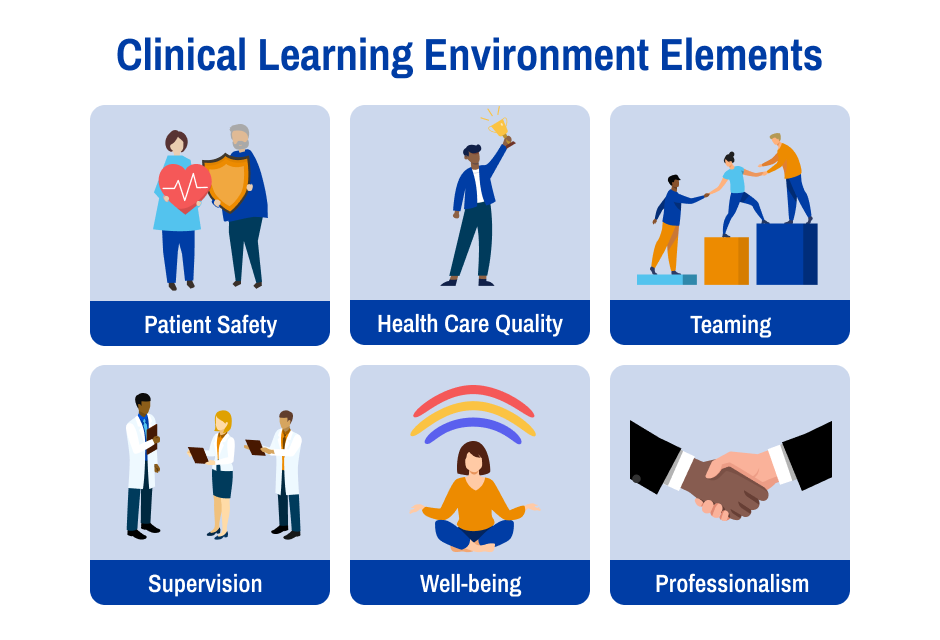Understanding and Improving the Clinical Learning Environment
In 2009, researchers compared maternal complications of delivery and stratified the complication rates into quintiles of residency programs based on where the delivering obstetrician completed their training. In comparing the quintile with the highest complication rate to the quintile with the lowest complication rate, there was a 3.3% absolute risk reduction in maternal complications. It matters where your obstetrician completed residency.
Physicians are a product of the environment in which they train. Therefore, clinician-educators should understand what the clinical learning environment is and how it might be optimized.
Medical education occurs in a complex system incorporating work-based training, individual and team learning, and patient care. The clinical learning environment may be thought of as the intersection between the clinical work setting and the myriad forms of medical education that occur in that setting. The clinical learning environment includes medical centers, ambulatory sites, and any other health care setting where learning takes place in the context of patient care delivery. It involves the vast array of cultural norms, hierarchies and behaviors that drive the vocation of medicine, including professionalism, social justice and equity. The clinical learning environment can also include other domains involved with patient care, such as error mitigation and improvement practices, technology, and personal well-being.
Clinical Learning Environment Elements
There are many ways to describe and define the various and overlapping clinical learning environment elements. Clinician-educators should be familiar with the areas of focus defined in the CLER Pathways to Excellence and the NCICLE Pathways to Excellence that describe optimal clinical learning environments.
- Patient safety
- Health care quality
- Teaming
- Supervision
- Well-being
- Professionalism
For each focus area, there are several pathways describing expectations for an optimal clinical learning environment. For example, “education on supervision” and “culture of supervision” are component pathways of the “supervision” domain. Improving the culture of supervision will result in improvements to the overall clinical learning environment. Conversely, a clinical learning environment that has a ‘poor’ culture of supervision may negatively affect other focus areas, potentially leading to inadequate educational and clinical outcomes. Any high-quality clinical learning environment should foster a culture that promotes safe care, well-being, professionalism, and high-performing teams. As the clinical learning environment improves, patient care and education are likely to improve.

Clinical Learning Environment Threats
There are challenges in supporting an optimal clinical learning environment. Many are inherent in the current structure of medical training. These challenges can include:
- Rotational nature: Training programs organize clinical curriculum by rotations, largely lasting between two and eight weeks. Such structure can prevent effective teaming to enhance safety and quality efforts.
- Time-limited: Medical training has an end date when many trainees leave for additional training or employment as independent practitioners. This turnover can affect organizational culture and teaming needed for high-performing organizations.
- Work allocation: Residents and fellows tend to work more hours in the week and more days than other clinicians. Often, trainees may be asked to fill in gaps in practice coverage such as overnight call, night shifts, weekends or excess patient load. Potential lack of agency, concern for future fellowship placement or employment, and the degree of hierarchy may affect an equitable distribution of work.
- Work duration: Work hour expectations, both historically and per ACGME restrictions, contrast with the science of burn-out and fatigue impairing optimal performance.
- Task-switching: The nature of resident work can require constant changes of cognitive tasks. Examples include the switch from days to nights for hospital-based programs, interruptions during the day, and contextual switching from clinical work to an educational conference. This may not reflect what trainees encounter in their post-training practice.
- Adequate preparation for the rigors of practice: A major purpose of medical training is to impress upon trainees that they are entering into a vocation. Professional training must support the growth of competence, provide adequate clinical experience and replicate the profession.
Moving Toward an Improved Clinical Learning Environment
All those who work in the clinical learning environment have the potential to positively influence it. This influence is not limited to those in leadership roles, such as clerkship directors, program directors, or division heads or chairs. Clinician-educators should be aware of their own influence on the clinical learning environment and consider strategies in their educational practice to positively influence it. The bedrock of a strong clinical learning environment occurs where the interface of teaching and patient care occurs. Effective clinical teaching that supports the clinical learning environment requires skills beyond good clinical care; other skills, such as clearly communicating expectations, effective use of teaching modalities, and managing the team, add to the effectiveness of clinical teaching. Opportunities for clinician-educators to positively affect the clinical environment include:
- Time-limited: As a new surgical resident starts on a trauma rotation, the attending leads the first time-out on the first few cases, introducing the new members of the team to the operating room staff. For the next case, the resident performs the same. The attending remains in the background to signify and support that the resident is leading the team activity, offering appropriate autonomy while the trainee is under direct supervision.
- Work duration: Noting how the distribution of patients on a call day consistently requires the on-call resident to stay later than expected, the attending raises this issue with program leadership and offers suggestions to improve workflow. In consideration of the late evening, the attending re-affirms that the residents are not to return until 10 hours after leaving the hospital, and shows up earlier the next day to see a few patients with medical students to offer residents time to prepare.
- Task-switching: Recognizing a busy post-call day of rounds, the clinician-educator stops rounds a few minutes early and sees a few long-term patients alone. The clinician-educator offers to call a couple of consults and insists that the trainees take a break to eat and drink before participating in the noon conference. To support the trainees, the clinician-educator answers messages for the clinical team during the conference hour.
Those in clinical training program leadership must also consider the broader view of the clinical learning environment. Opportunities for leaders to address different threats may include:
- Rotational nature: Consider alternate ways to arrange the clinical learning environment to promote team-based care and integrated teams. For example, some internal medicine programs have adopted geographically based inpatient teams to orient trainees on a single inpatient floor integrated with other interprofessional team members.
- Allocation of work: Recognize certain rotations or experiences that lead to exhaustion and embrace an environment that prioritizes competence and caring. Practical solutions may be hanging the rotation such that there are more days off, a reduction in patient census, or the addition of other personnel to offset the burden.
- Adequate preparation for rigors of practice: Difficult rotations — such as an ICU night rotation for a critical care fellow — may be formative and fundamental for the practice of medicine despite the stressors. The clinician-educator strives to promote a culture of vulnerability and self-expression by recognizing the strain of the rotation, even admitting their own struggle as a trainee, and empathizing with the trainee in their journey towards professional autonomy.
In sum, the clinical learning environment is a fundamental concept for clinician-educators to understand, as they can all help to optimize the environment. By doing so, clinician-educators foster a better environment for trainees and work to encourage better clinical outcomes for patients.
About the Author
